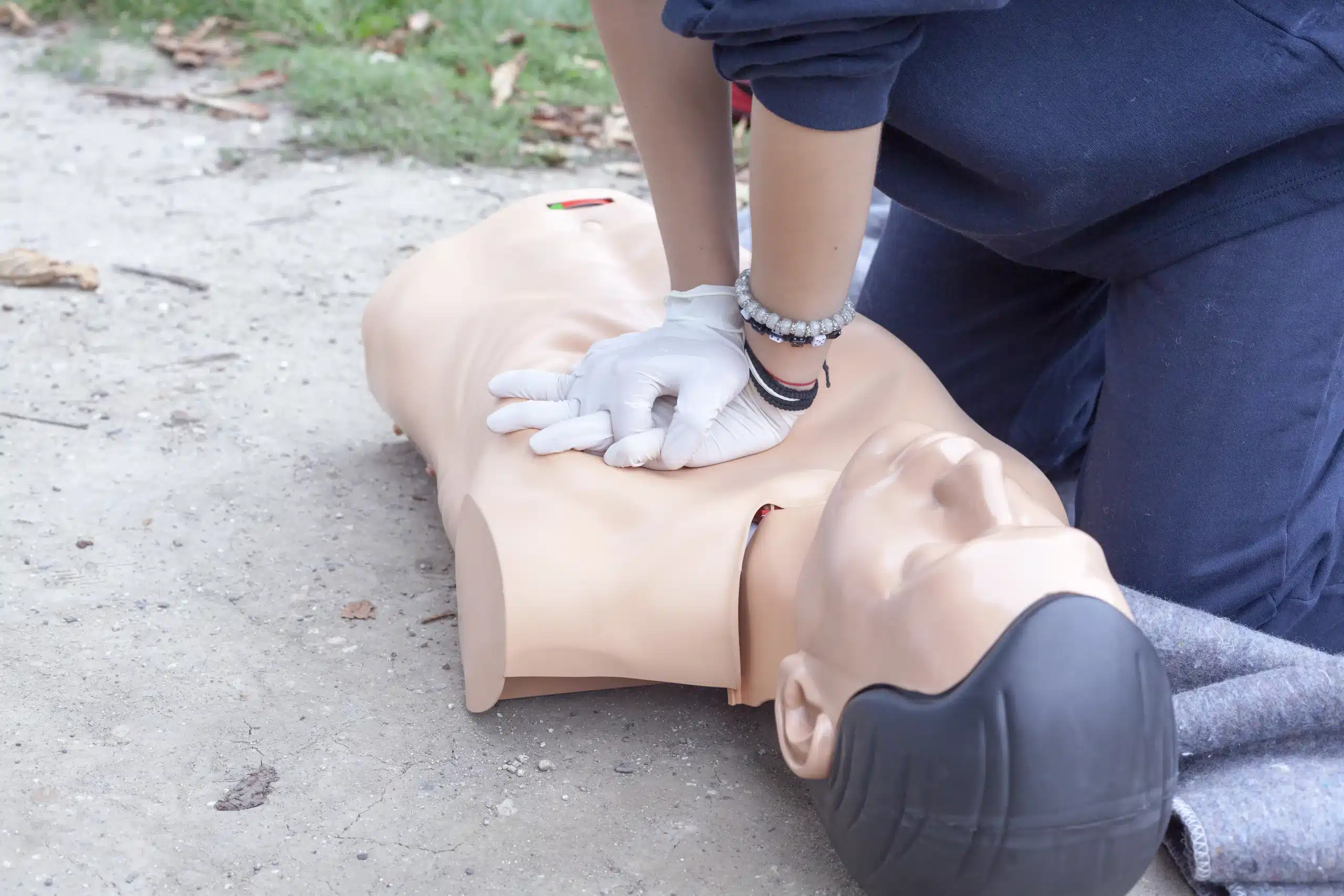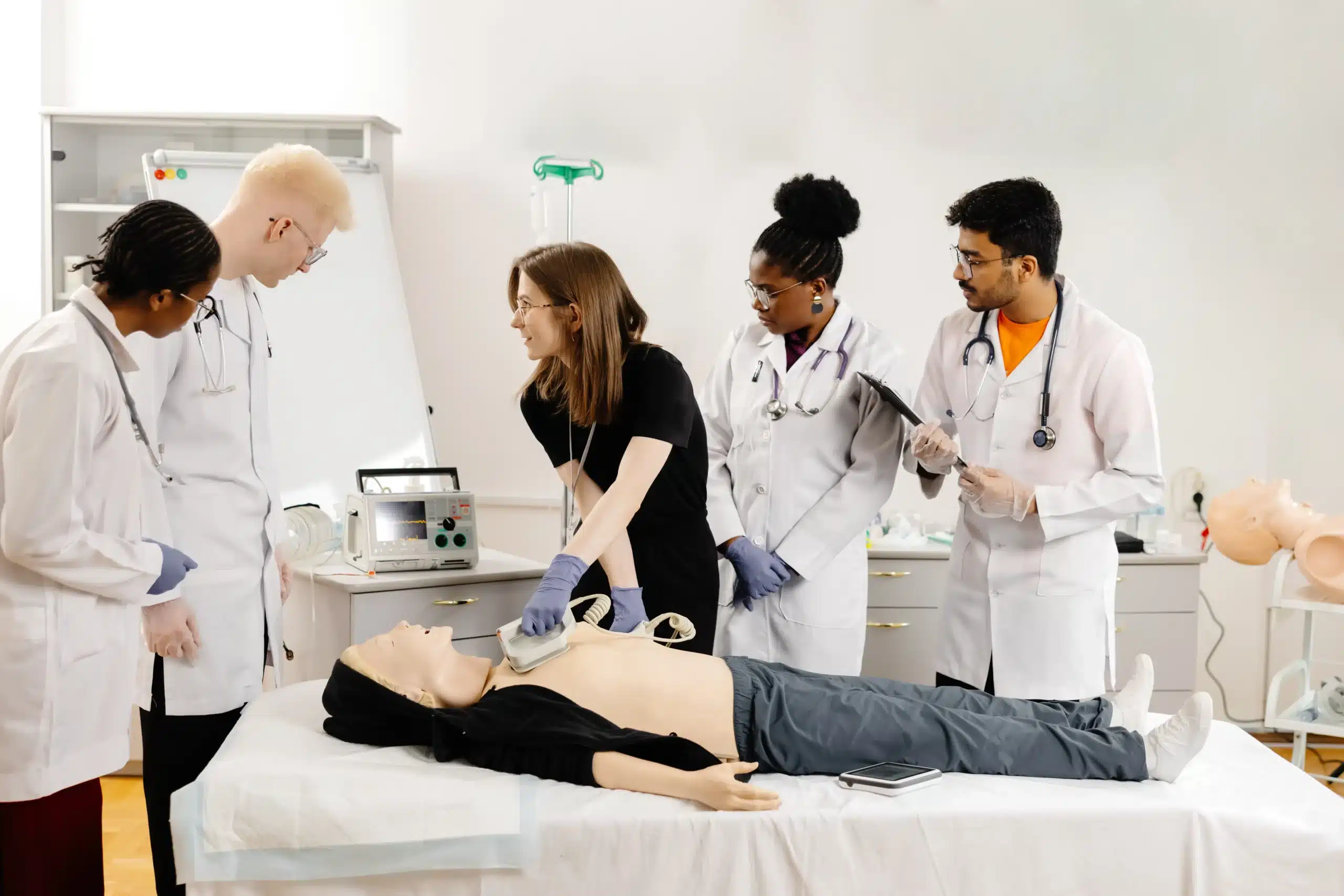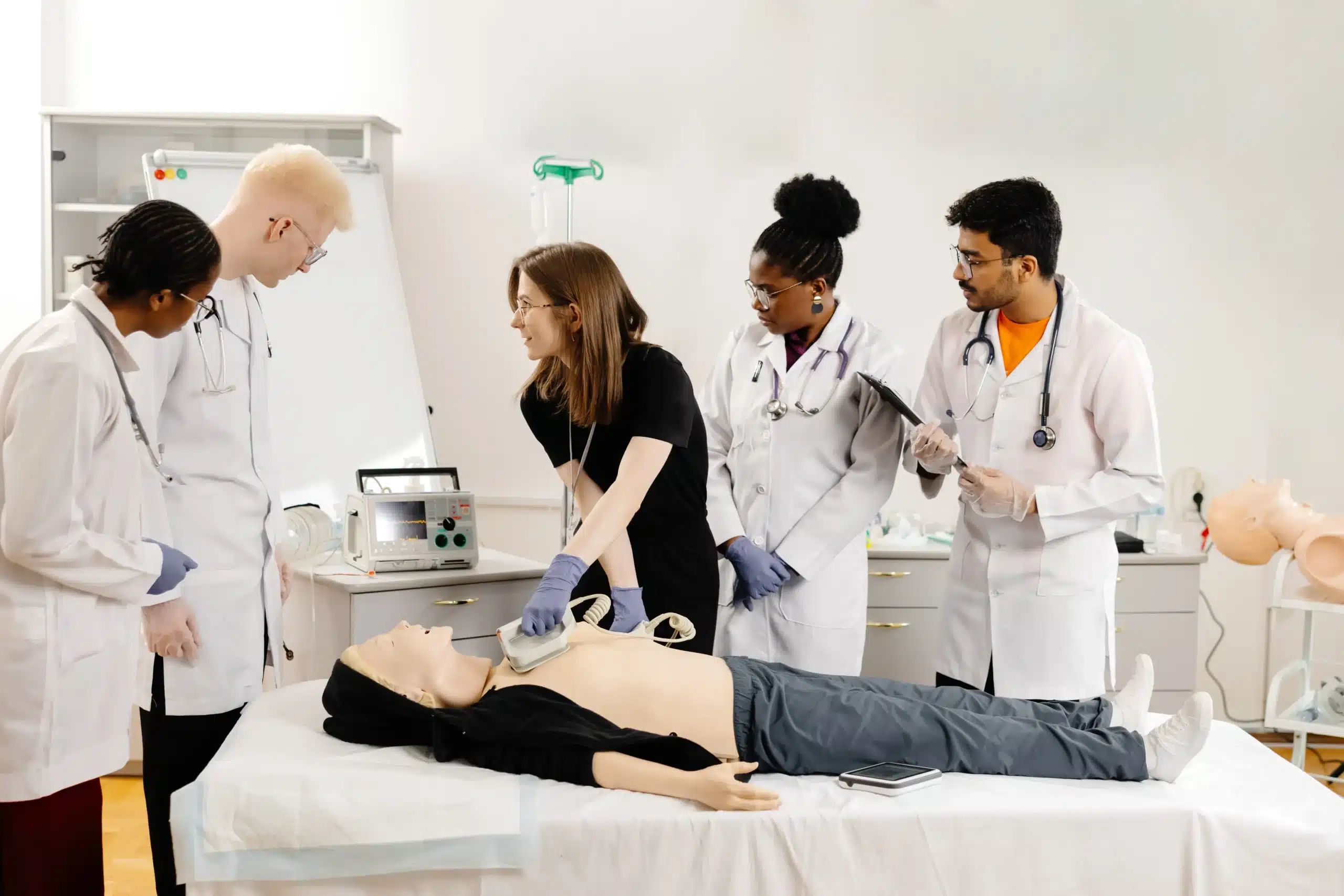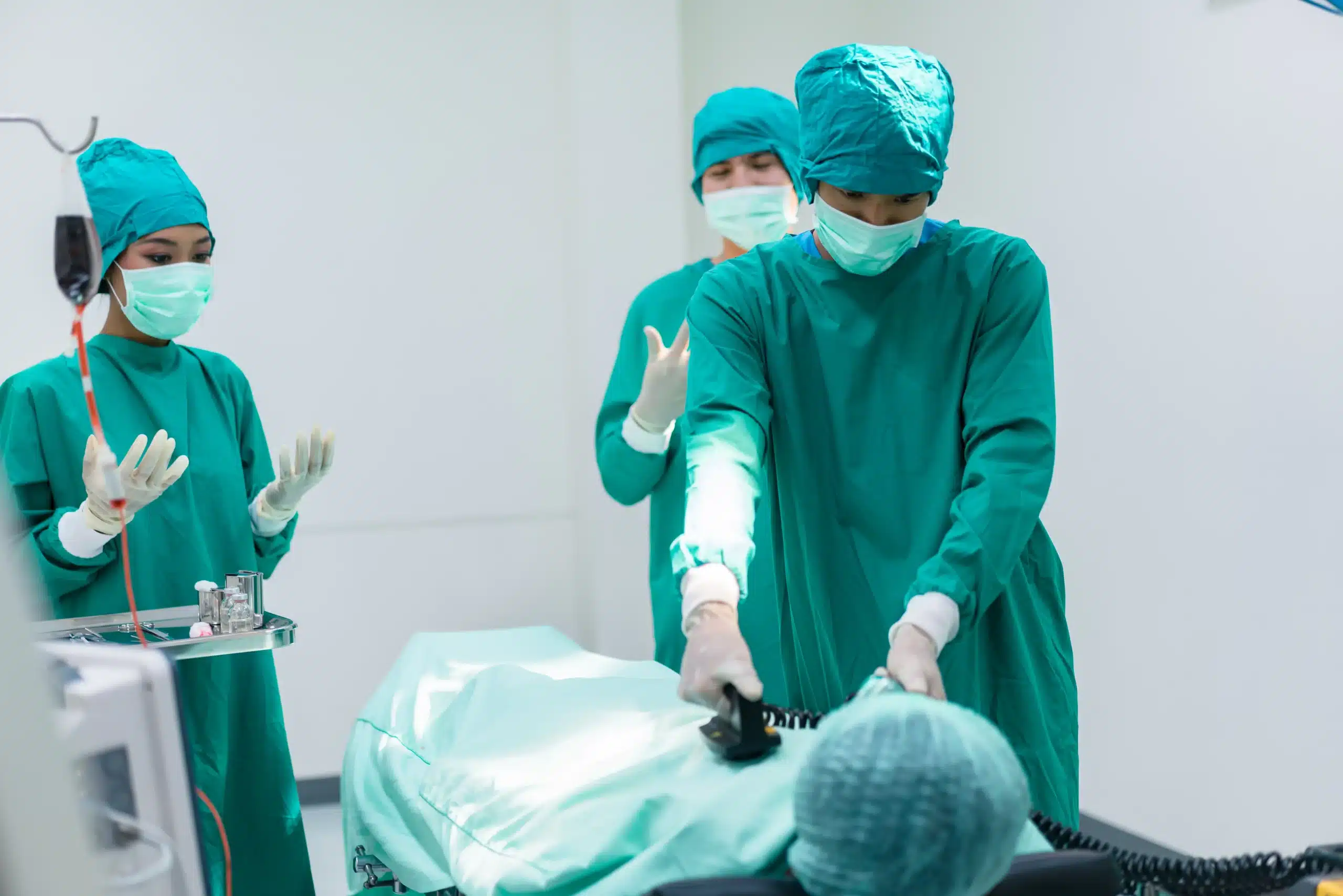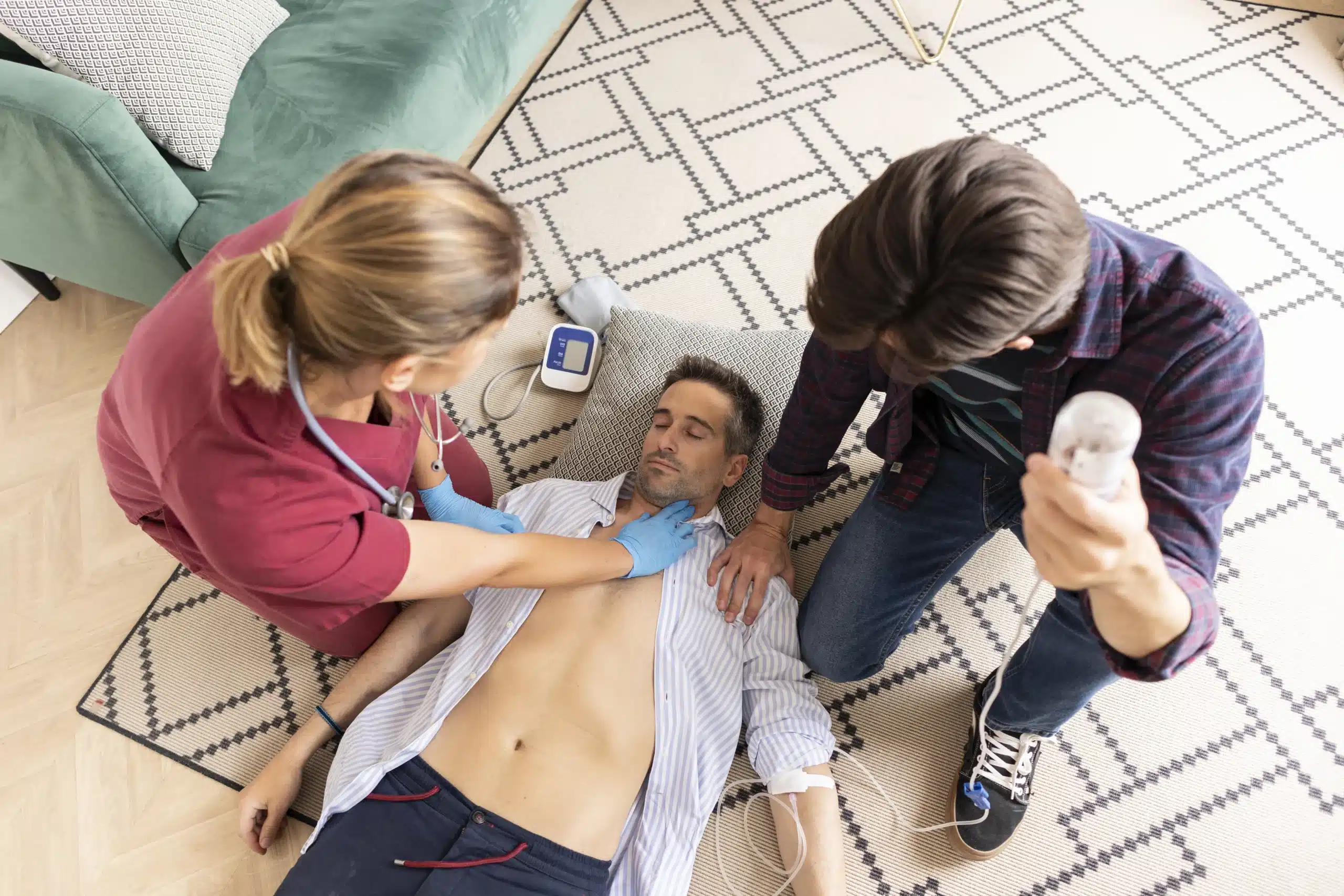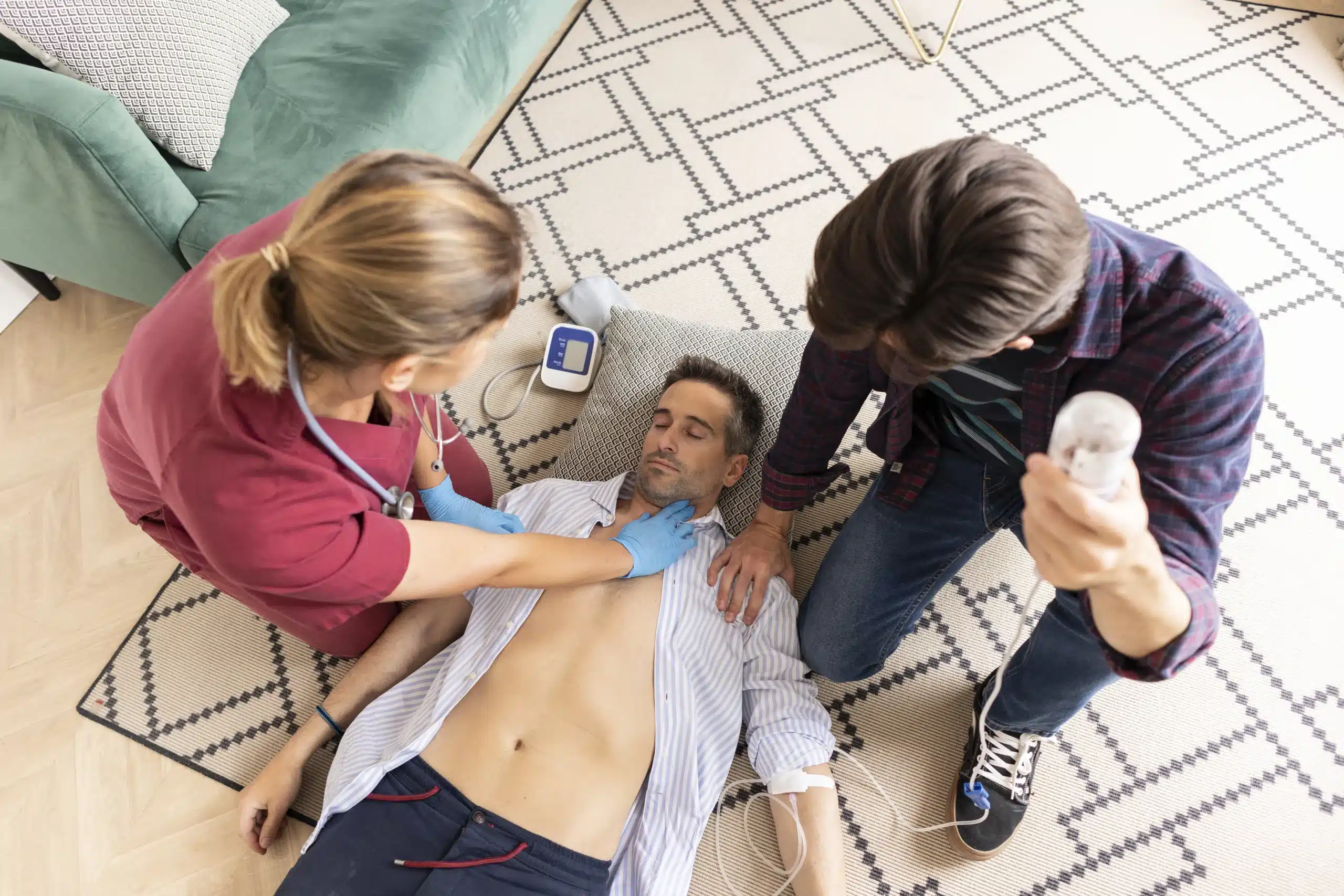Knowing CPR can transform you from a bystander to a lifesaver. If you’re searching for “CPR certification near me,” this guide will provide you with the essential information you need to get started. We’ll explore the different types of CPR courses available, including BLS, ACLS, PALS, and CPR/First Aid, and discuss the importance of choosing an accredited training provider. We’ll also cover the costs of CPR certification, the various learning formats available, and how to maintain your skills once you’re certified. Whether you’re a healthcare professional, a childcare provider, or simply someone who wants to be prepared for emergencies, this guide will help you find the right CPR certification to empower you to act confidently and effectively.
Key Takeaways
- CPR certification empowers you in emergencies: Equipping yourself with these skills allows you to confidently respond to various emergencies, providing vital support until professional help arrives. Choose a certification level—from basic CPR/first aid to advanced options like ACLS and PALS—that aligns with your specific needs and career goals.
- Selecting the right CPR course requires research: Consider factors like the provider’s accreditation, course format (in-person, online, or blended), instructor experience, and overall cost. Compare different providers to find the best fit for your learning style, schedule, and budget. Explore options like group discounts or on-site training for added convenience and potential cost savings.
- Maintaining your CPR skills is an ongoing commitment: Stay prepared by renewing your certification and keeping up-to-date with the latest guidelines and techniques. Regular practice and continuing education courses reinforce your skills and boost your confidence, ensuring you’re always ready to respond effectively.
What is CPR Certification?
CPR certification proves you can perform cardiopulmonary resuscitation (CPR) and other life-saving techniques during emergencies. It’s a vital credential for many professionals—healthcare providers, teachers, childcare providers, and lifeguards, to name a few. But even if it isn’t required for your job, knowing these skills can make a real difference. CPR and first aid training from a recognized provider like the American Heart Association or American Red Cross equips you with the knowledge and skills to respond effectively to emergencies.
During your CPR training, you’ll learn essential skills like chest compressions, rescue breaths, and how to use an automated external defibrillator (AED). These skills are crucial for providing immediate assistance to someone experiencing cardiac arrest or other life-threatening situations. The certification process typically involves both a written exam and a practical skills test, ensuring you can perform CPR competently and confidently under pressure. Fairfield CPR Classes offers a low-price guarantee and convenient daily classes, making it easier than ever to get certified. Contact us to learn more.
CPR Certification Courses
Knowing which CPR class is right for you can feel overwhelming with so many options. This section breaks down common CPR certifications, from basic to advanced, so you can choose the best fit. Fairfield CPR Classes offers a variety of courses to meet your specific needs. Check out our CPR and First Aid Certification Courses for more details.
Basic Life Support (BLS)
BLS certification focuses on single-rescuer CPR and is essential for healthcare providers like doctors, nurses, paramedics, and other medical professionals. It covers high-quality CPR for adults, children, and infants, using an AED, and relieving choking. BLS also emphasizes teamwork and clear communication during emergencies. If you’re pursuing a healthcare career, BLS certification is usually required.
First Aid & CPR
Combining CPR training with first aid skills prepares you to handle various emergencies. This certification is valuable for anyone, from parents and teachers to workplace safety officers and childcare providers. You’ll learn how to respond to common injuries like cuts, burns, and fractures, and manage medical emergencies until help arrives. Fairfield CPR Classes offers combined CPR and First Aid certification, making it easy to develop both skill sets.
Pediatric CPR
Designed for those who work with children—including childcare providers, teachers, and camp counselors—Pediatric CPR focuses on specific techniques for infants and children. It covers CPR, choking relief, and recognizing signs of distress in a child. In California, licensed childcare providers have specific requirements, and Fairfield CPR Classes offers Pediatric First Aid CPR AED certification that meets these EMSA guidelines.
Advanced Cardiac Life Support (ACLS)
ACLS certification provides advanced training for healthcare professionals who manage cardiopulmonary arrest and other cardiovascular emergencies. Building on BLS, it incorporates complex procedures like airway management, pharmacology, and ECG interpretation. For doctors, nurses, or paramedics, maintaining your ACLS certification is crucial for providing excellent patient care.
Pediatric Advanced Life Support (PALS)
Similar to ACLS, PALS is an advanced course for healthcare providers treating critically ill infants and children. It covers pediatric-specific emergencies, including respiratory distress, shock, and cardiac arrest. PALS emphasizes a systematic approach to assessment, stabilization, and treatment. Like ACLS, PALS certification is essential for healthcare professionals in pediatric emergency or critical care.
Compare CPR Certification Providers
Finding the right CPR certification means understanding what each provider offers. Several organizations provide CPR training, each with its own strengths. Here’s a breakdown of some of the leading providers to help you make an informed choice.
American Heart Association (AHA)
The American Heart Association is a leader in CPR and first aid training. Their courses, from Basic Life Support (BLS) to Advanced Cardiovascular Life Support (ACLS), are highly respected and widely accepted, especially in healthcare. The AHA emphasizes hands-on training to build practical skills. An AHA certification is often preferred for healthcare careers.
American Red Cross (ARC)
The American Red Cross is another trusted provider of CPR and first aid courses. Designed for all skill levels, their certifications are recognized across many industries. The ARC’s focus on emergency preparedness makes their certification valuable for everyone.
National CPR Foundation (NCPRF)
The National CPR Foundation offers accredited certification courses that align with the guidelines of organizations like the AHA. They focus on accessible and convenient training, often with an emphasis on affordability and flexible scheduling.
ProTrainings
ProTrainings offers a blend of online and in-person CPR and first aid training. This flexible approach works well for busy schedules. They offer courses for both individuals and organizations.
Fairfield CPR Classes
Fairfield CPR Classes offers various AHA-aligned CPR and first aid courses in Fairfield, CA. We focus on hands-on training and small class sizes for personalized instruction and confidence-building. Serving Fairfield, Vacaville, and Suisun City, we offer daily classes and group discounts, making quality training accessible. Explore our CPR and first aid certification courses for more details. We also offer specialized training like RQI and have a low price guarantee. Contact us to find the right class for you.
Choose the Right Course Format
When it comes to CPR certification, you have several learning options. Understanding the differences between in-person, online, and blended learning will help you choose the best format for your needs. Each format has its own advantages and disadvantages, so consider your learning style, schedule, and professional requirements.
In-Person Classes
In-person CPR classes offer hands-on training and direct interaction with a certified instructor. This format is ideal for kinesthetic learners who value real-time feedback. Instructors guide you through the steps of CPR, demonstrate proper techniques, and provide personalized coaching. This immersive experience builds confidence and prepares you to respond effectively in real-life emergencies. Fairfield CPR Classes offers a range of in-person courses, including BLS, ACLS, PALS, and CPR/First Aid. For those located in Solano County, in-person classes are available in Fairfield, Vacaville, and Suisun City.
Online Certification
Online CPR certification offers flexibility and convenience. You can complete the coursework at your own pace, anytime, anywhere. This format often involves video tutorials, interactive exercises, and online exams. While online certification can be a good option for those with busy schedules or limited access to in-person classes, it’s important to be aware of its limitations. Online-only training typically lacks the hands-on component crucial for developing the muscle memory and practical skills needed to perform CPR effectively. Also, the legitimacy and acceptance of online-only CPR certifications vary based on your profession and state regulations, so check your local requirements. If your profession requires in-person training, an online-only course may not meet those standards.
Blended Learning
Blended learning combines the flexibility of online learning with the practical application of in-person skills practice. This format allows you to complete the cognitive portion of the course online at your convenience, then attend a shorter in-person session to practice your skills and receive feedback from an instructor. Blended learning CPR courses are often acceptable where in-person training is a requirement. This hybrid approach offers a good balance between convenience and hands-on learning, making it a popular choice.
Choose a CPR Course: Factors to Consider
So you’ve decided to get CPR certified—fantastic! Now, how do you choose the right course? It can feel a little overwhelming with so many options, but focusing on a few key factors can simplify your decision.
Accreditation and Recognition
First things first, make sure the course you choose is accredited by a reputable organization. Both the American Heart Association (AHA) and the American Red Cross (ARC) offer widely recognized certifications. Employers often prefer one or the other, so check if your workplace has a preference. For most people seeking general CPR knowledge, either organization is a solid choice. If you’re in Fairfield, Vacaville, or Suisun City, Fairfield CPR Classes offers a range of AHA-accredited courses.
Course Duration and Flexibility
Life gets busy, so finding a course that fits your schedule is essential. Course duration can vary, so consider how much time you can realistically commit. Look for providers that offer weekend or evening classes, or even accelerated options if you’re pressed for time. Some providers also offer on-site training for groups, which can be a convenient option. Think about what works best for your lifestyle.
Hands-On Practice
CPR is a hands-on skill, and you’ll learn best by doing. A good CPR course should emphasize hands-on practice with mannequins and other training equipment. This allows you to develop muscle memory and gain confidence in your abilities. Ask potential providers about the student-to-instructor ratio and the amount of practice time included in the course. Fairfield CPR Classes prioritizes hands-on training to prepare students for real-life emergencies.
Instructor Qualifications
Your instructor plays a crucial role in your learning experience. Look for certified instructors with significant experience teaching CPR. A knowledgeable and engaging instructor can make all the difference in your understanding and retention of the material. Check if the instructors are healthcare professionals or have a strong background in emergency medical services. Experienced instructors who are passionate about their work can create a positive and effective learning environment.
Cost and Value
CPR certification doesn’t have to be expensive. Course costs can vary depending on the provider, location, and type of certification. While it’s tempting to go for the cheapest option, consider the overall value. A slightly more expensive course might offer smaller class sizes, more hands-on practice, or more experienced instructors. Fairfield CPR Classes offers a low-price guarantee, ensuring you get the best possible value. Don’t hesitate to contact us to discuss pricing and available discounts.
CPR Certification Costs: A Comparison
CPR certification costs vary, so it’s helpful to understand the factors influencing price. From course type and format to provider and location, several variables determine the final cost. Let’s break down the typical price ranges, additional fees, and potential discounts.
Typical Price Ranges
Generally, CPR certification courses range from $70 to $150. Basic CPR and First Aid certification often falls at the lower end of this spectrum. More specialized courses like ACLS or PALS for healthcare providers typically command higher prices due to their advanced content and longer duration. Remember that these are estimates, and prices can vary based on your location and the specific training center. Fairfield CPR Classes offers a low-price guarantee.
Additional Fees
Beyond the base course fee, be aware of potential additional fees. Some providers might charge extra for certification cards, course materials, or online access codes. Always confirm the total cost upfront to avoid surprises. Contact us if you have questions about our pricing.
Discounts and Special Offers
Many CPR training providers offer discounts, especially for groups, students, or returning customers. Look for special promotions or seasonal deals that can lower the overall cost. Sometimes bundling CPR certification with First Aid or other courses can also lead to savings.
Group and Corporate Discounts
If you’re certifying a group of employees or colleagues, explore group or corporate discounts. These can significantly reduce the per-person cost, making training your entire team more affordable. Contact Fairfield CPR Classes to discuss options for on-site training at your location. This convenient approach makes it efficient to meet your company’s safety training needs.
Evaluate Provider Reputation and Quality
Finding the right CPR certification course involves more than just convenient times and a nearby location. It’s about trusting your training to a reputable provider that meets high standards. Here’s how to evaluate the quality and reputation of potential CPR training providers:
Check Credentials
First, verify the provider’s credentials. Are they affiliated with a nationally recognized organization like the American Heart Association (AHA) or the American Red Cross? Legitimate providers will clearly state their affiliations and certifications. For example, Fairfield CPR Classes offers a range of AHA-certified courses, including BLS, ACLS, PALS, and CPR/First Aid. This alignment ensures the training reflects the latest emergency care guidelines. Look for providers who emphasize hands-on training, like the BLS certification courses at
Read Student Testimonials
What are past students saying? Student reviews and testimonials offer valuable insights into the quality of instruction, the learning environment, and the overall experience. Providers who take pride in their teaching, like the instructors at Fairfield CPR Classes, often showcase positive feedback. Take the time to read through these testimonials to understand the provider’s strengths and weaknesses.
Evaluate Course Success Rates
While not always readily available, course success rates can be a helpful metric. Inquire about the percentage of students who successfully complete the certification process. A high success rate suggests effective teaching methods and comprehensive course materials. CPR certification equips individuals with the skills and confidence to respond effectively in emergencies, and a provider’s success rate can reflect their commitment to preparing students. If this information isn’t readily available, don’t hesitate to ask the provider directly.
Maintain Your CPR Certification
Earning your CPR certification is a fantastic achievement, but staying current is equally important. Knowing how to maintain your skills ensures you’re always prepared to help in an emergency. This section covers everything you need to know about renewal requirements, continuing education, and staying up-to-date on the latest guidelines.
Renewal Requirements
CPR certifications, like those from the American Heart Association, are typically valid for two years. After this period, you’ll need to take a renewal course to keep your skills and knowledge current. Renewal courses cover core CPR techniques and any updated guidelines. Don’t let your certification expire—staying certified means you’re always ready to respond effectively. Check with your certifying organization or Fairfield CPR Classes for renewal course options.
Continuing Education
Even if your certification isn’t up for renewal yet, participating in continuing education courses offers significant benefits. These courses offer refreshers on essential skills and can introduce new developments in CPR techniques. Regular training reinforces the importance of quick action in emergencies and builds confidence. Think of it as a tune-up for your lifesaving skills.
Stay Updated on Guidelines
CPR guidelines can change based on the latest research and best practices. Organizations like the American Heart Association regularly update their recommendations. To maintain your certification and provide effective care, stay informed about these changes. Check the AHA website or consult with a certified CPR instructor to ensure you’re practicing the most current techniques. Staying updated demonstrates your commitment to providing high-quality CPR.
Find CPR Certification Near You
Locating a CPR class that fits your schedule and needs is easier than you think. Here are a few ways to find CPR certification near you:
Use Online Search Tools
Start with a simple online search. Type “CPR classes near me” or “CPR certification [your city]” into your search engine. This will generate a list of training centers and other organizations offering CPR courses in your area. You can also use more specific search terms, such as “American Heart Association CPR classes” or “BLS certification near me,” if you’re looking for a particular type of course or provider. For those in and around Fairfield, Vacaville, and Suisun City, Fairfield CPR Classes offers a range of courses—from basic CPR and first aid to advanced certifications like ACLS and PALS. Finding the right course can give you the confidence to act quickly and potentially save a life.
Contact Local Healthcare Facilities
Hospitals, clinics, and other healthcare facilities often offer CPR training to their staff and the community. Contact your local hospitals or clinics to inquire about upcoming CPR courses. These facilities are a good resource for finding BLS certification, which is often a requirement for healthcare professionals and students. Look for courses certified by either the American Heart Association (AHA) or the American Red Cross (ARC)—both are reputable providers of CPR and first aid training.
Check Community Centers and Schools
Community centers, schools, and other community organizations frequently host CPR classes. Check with your local community center, YMCA, or recreation department to see if they offer CPR training. Many also offer CPR and first aid classes for specific groups, such as teachers, childcare providers, and coaches. These classes are a great way for community members to learn these vital, lifesaving skills.
Choose the Best CPR Certification
Finding the right CPR certification involves a few key steps. Start by selecting a reputable training provider. Both the American Heart Association (AHA) and the American Red Cross (ARC) offer widely recognized certifications. For courses aligned with AHA guidelines, consider providers like Fairfield CPR Classes, which offers various AHA courses, including BLS, ACLS, PALS, and CPR/First Aid. Ensure the provider you choose is accredited and their certifications meet the requirements of your workplace or field.
Next, determine the specific type of CPR training you need. Are you a healthcare provider needing BLS certification? Or are you simply looking for a more general CPR and First Aid course? Understanding the differences between BLS, ACLS, PALS, and First Aid will help you choose the right course. Fairfield CPR Classes emphasizes hands-on training in their BLS courses, which is essential for building confidence in emergencies.
Finally, consider the course format and your learning style. Do you prefer in-person instruction, the flexibility of online learning, or a blended approach? Factor in your schedule and how you learn best. Also, compare costs and look for potential savings. See if the provider offers group discounts or other special offers. Fairfield CPR Classes has a low price guarantee, giving you peace of mind about the value you receive. If you have questions, reach out to the provider directly. You can contact Fairfield CPR Classes for more information about their programs. Choosing the right CPR certification is an investment in your skills and your ability to respond effectively in critical situations.
Related Articles
- Why CPR is Crucial in Healthcare – CPR & First-Aid Training
- CPR Classes in Fairfield: Find the Right Course – Fairfield CPR Classes
- CPR Renewal in Fairfield: Your Complete Guide – Fairfield CPR Classes
- Find CPR Courses Near Me: A Comprehensive Guide – Fairfield CPR Classes
- Group CPR Discount Classes in Fairfield, CA – Fairfield CPR Classes
Frequently Asked Questions
How do I choose between American Heart Association (AHA) and American Red Cross (ARC) CPR certification?
Both the AHA and ARC are highly respected. AHA certifications are often preferred in healthcare settings, while ARC certifications are widely accepted across various industries. Consider your specific field and employer preferences when making your decision. If you’re unsure, contact your employer or licensing board for guidance.
What if I’m nervous about the skills testing portion of the CPR course?
It’s completely normal to feel a little apprehensive about the skills test. Remember, CPR instructors understand this and create a supportive learning environment. The emphasis is on learning and practicing. Take advantage of the hands-on practice time during the course and ask your instructor any questions you have. The more you practice, the more confident you’ll become.
Is online-only CPR certification enough, or do I need an in-person class?
While online CPR courses offer flexibility, they often lack the crucial hands-on practice component. Many employers and regulatory bodies require in-person training, especially in healthcare. Blended learning, which combines online coursework with in-person skills practice, can be a good compromise. Check with your employer or licensing board to confirm their requirements.
How often do CPR guidelines change, and how can I stay updated?
CPR guidelines are updated periodically to reflect the latest scientific research and best practices. The American Heart Association is a primary source for these updates. Check their website or subscribe to their newsletters to stay informed about any changes. Also, consider taking refresher courses or continuing education classes to maintain your skills and knowledge.
What if I don’t work in healthcare? Do I still need CPR certification?
Knowing CPR can be invaluable in any situation, not just healthcare settings. Emergencies can happen anywhere, and having the skills to respond can make a real difference. While it might not be a job requirement for everyone, CPR certification empowers you to assist family, friends, or even strangers in a critical situation. It’s a valuable life skill to have.
